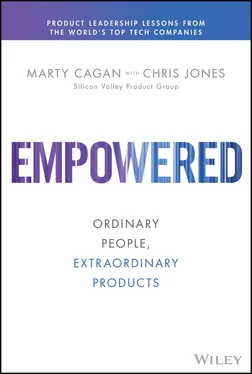Now that we have the skills taxonomy, the core of this technique is a gap analysis. The way this works is that the manager should review the set of criteria above and assign two ratings to each skill.
Expectations vs. Current Capability
The first rating is an assessment of where the employee needs to be in this skill (i.e., expectations rating), and the second rating is an assessment of where the employee currently performs on this scale (i.e., her capability ). I typically rate these on a 1–10 scale, with 10 being a skill that is absolutely essential to the job.
So, for example, if you consider a skill such as “Product Discovery Techniques” an 8 in expectations, yet you assess your product manager's current capability as a 4, then there is a significant gap for a critical skill, and you'll need to get to work coaching the product manager on her knowledge or skills in this key area.
Note: Normally, the difference between a product manager and senior product manager, for example, is captured in the expectations of where the level of skills should be (the expectations rating). As just one example, I usually rate stakeholder collaboration skills a 7 in expectations for a standard product manager‐level person, yet I consider this skill a 9 for a senior product manager.
Note: The level of expectations is always set by the manager, if not the organization as a whole. Most of our effort is in determining the capability rating . Normally, the assessment of the product manager's capability level is done by the manager. However, there is no reason why the product manager can't also do a self‐assessment, and in fact I encourage that. But be aware that it is not at all uncommon for the self‐assessment to expose some significant differences with how the product manager assesses her own capabilities. A manager that only relies on the self‐assessment because she is uncomfortable confronting these differences in perception is, in my view, abdicating her responsibility as a manager.
Now that we've done a skills assessment and subsequent gap analysis, we are looking for the areas with the biggest gaps. That's the purpose of this assessment.
For the coaching plan, I like to limit the initial focus to the top‐three areas. After progressing on these, the product person can move on to the next most important areas.
As the manager, you can now provide this product person with coaching, training, reading, or exercises intended to develop her skills in each area.
In the next chapter, I will share what I typically recommend in a coaching plan for developing each skill in the taxonomy described above. But many of you already know how to coach a product manager in a specific skill, so all you really need is the assessment and gap analysis described here.
Also, once an employee has successfully closed the gaps, it is the ideal time to show her how the expectation ratings move for the next‐level position, and she can set about developing and demonstrating the skills necessary for a promotion.
Be sure to sit down with each of your product people no less than once a week to discuss progress on the coaching plan.
Assessments vs. Performance Reviews
Finally, you might be wondering how this sort of skills assessment and coaching plan relates to performance reviews. We will discuss performance reviews in more detail in the next part of the book on Staffing.
In general, I find the way most companies implement performance reviews to be of little use in terms of developing people. Sadly, they are more about HR compliance and salary administration.
You may have to comply with your HR department's requirements in terms of annual reviews, but just realize that these are in no way an adequate substitute for active, ongoing, engaged coaching and development of each team member's skills.
One thing to be careful of is that your ongoing efforts to coach your employees to be ready for promotion are not the same as being able to grant that promotion. Many companies have policies regarding when promotions can be granted, so you don't want to set expectations with your employee that you can't deliver on. The way I phrase this with the employee is that I will make every effort to prepare the employee for promotion, and then I will advocate for that promotion, but I can't always guarantee if and when that promotion will happen.
The good news is if you actively manage the skills assessment and the coaching plan as I describe here, then the annual review fire drill will be much easier.
CHAPTER 9
The Coaching Plan
In the previous chapter, I defined a tool to assess the current skill level of a product person in order to identify skill gaps.
In this sequel chapter, I would like to share how I coach product people on each of these specific gaps.
In truth, the full version of this coaching plan is really this entire book, but I am hopeful that I can provide enough examples and suggestions in this chapter to help most managers give useful guidance and coaching.
Note that I am using the same people, process, and product taxonomy of skills that I spelled out in the previous chapter, so if you are unsure what any of these topics are about, please refer back to that chapter. And also, as with the assessment chapter, I am using the example of the product manager here, although much of what is written here will also be helpful for product designers and tech leads.
To set your expectations, product knowledge is where a new product manager spends most of her time in the onboarding process. It usually requires two to three months of time to ramp up, assuming she is provided the necessary coaching and she aggressively focuses on this for several hours per day.
But to be clear, a product manager that does not have this level of knowledge has no business serving as product manager for her team. And the responsibility for ensuring this level of competence is squarely on her manager.
User and Customer Knowledge
There really is no substitute for getting out of the office and visiting users and customers. That said, there is much to be gained by first taking advantage of the knowledge of your colleagues.
As you go about this learning, remember that each person you speak with brings their own perspective, and you're looking to understand that perspective and learn as many perspectives as possible.
If your company has a user research team, that's my favorite place to start, and it is a valuable relationship for the product manager to establish. User researchers are there to educate you—they know if you don't truly grok the issues, then you won't fix them.
Next, if you have a customer success or customer service team, that is a terrific resource. You want to learn who their favorite customers are, and their least favorite, and why. You will also want to spend quality time with this team to understand more about how customers perceive your product. But for now, you want to learn what they can teach you about your users and customers.
Product marketing is another valuable perspective on users and customers, and another important relationship for the product manager to establish. Product marketing will also have good insight into the broader sales and marketing organizations and the people you should talk with who will have useful perspectives.
In many companies, the founders or CEO have had more customer exposure than anyone, and they are another great resource. Ask the founders which customers they consider the most helpful for you to truly get to know and understand. You're not only looking for happy customers, just as you're not only looking for unhappy customers. You're after as many perspectives as you can get.
Читать дальше











